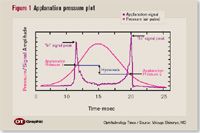Article
Device may help identify patients at risk for ectasia before LASIK
Proprietary instrumentation (Ocular Response Analyzer, Reichert Inc.) may provide clinical measures of corneal viscoelasticity (corneal hysteresis) and rigidity (corneal resistance factor). The device provides clinical information on the dynamic biomechanical properties of the cornea and may be able to identify eyes at risk of developing ectasia before LASIK.

Key Points

"The goal of our research was to determine if we can predict which patients will develop ectasia using different means other than the size and shape of the cornea," said Dr. Shimmyo, assistant professor of clinical ophthalmology, Department of Ophthalmology, New York Medical College. "The viscoelasticity of the cornea is another important feature that we studied."
The analyzer has an infrared ocular surface illuminator, an air tube, and an infrared light detector. The air tube emits air that hits the cornea.
The analyzer measures IOP with the cornea in motion at the inward applanation (Pressure 1 [P1], Figure 1) and the outward applanation (P2).
Corneal hysteresis (P1 – P2) represents viscous damping of the cornea. The corneal resistance factor (P1 – 0.70 × P2) represents the total corneal viscoelastic response to deformation, he said.
In a clinical observational study, Dr. Shimmyo and colleagues used measurements from the device to predict the development of ectasia before LASIK. They measured the corneal hysteresis and corneal resistance factor in 202 normal eyes of 103 subjects, in 98 eyes of 49 patients before and after LASIK, and in 76 eyes of 38 patients with keratoconus.
In normal eyes, he reported, the corneal hysteresis and the corneal resistance factor values were 10.28 ± 1.39 mm Hg (range, 6.40 to 15.00 mm Hg) and 10.76 ± 1.25 mm Hg (range, 7.90 to 15.20 mm Hg), respectively. In keratoconic eyes, the respective values were 8.30 ± 2.35 mm Hg (range, 3.70 to 13.60 mm Hg) and 7.15 ± 2.41 mm Hg (range, 1.60 to 12.00 mm Hg). Before LASIK, the respective values were 10.46 ± 1.71 mm Hg (range, 6.00 to 15.60 mm Hg) and 10.25 ± 1.88 mm Hg (range, 6.90 to 15.40 mm Hg), and after LASIK, 8.63 ± 1.72 mm Hg (range, 4.60 to 12.90 mm Hg) and 7.28 ± 1.82 mm Hg (range, 3.50 to 12.10 mm Hg).

These values also were significantly lower after LASIK compared with pre-LASIK values. Mean corneal hysteresis value after LASIK was 1.84 mm Hg lower than that of pre-LASIK eyes, and mean corneal resistance factor value was 2.97 mm Hg lower than that in pre-LASIK eyes (p < 0.0001 for both comparisons).
Newsletter
Don’t miss out—get Ophthalmology Times updates on the latest clinical advancements and expert interviews, straight to your inbox.




